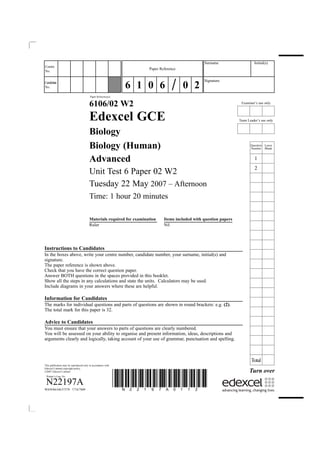June 2007 qp
- 1. Surname Initial(s) Centre Paper Reference No. Signature Candidate No. 6 1 0 6 0 2 Paper Reference(s) 6106/02 W2 Examinerâs use only Edexcel GCE Team Leaderâs use only Biology Biology (Human) Question Leave Number Blank Advanced 1 2 Unit Test 6 Paper 02 W2 Tuesday 22 May 2007 â Afternoon Time: 1 hour 20 minutes Materials required for examination Items included with question papers Ruler Nil Instructions to Candidates In the boxes above, write your centre number, candidate number, your surname, initial(s) and signature. The paper reference is shown above. Check that you have the correct question paper. Answer BOTH questions in the spaces provided in this booklet. Show all the steps in any calculations and state the units. Calculators may be used. Include diagrams in your answers where these are helpful. Information for Candidates The marks for individual questions and parts of questions are shown in round brackets: e.g. (2). The total mark for this paper is 32. Advice to Candidates You must ensure that your answers to parts of questions are clearly numbered. You will be assessed on your ability to organise and present information, ideas, descriptions and arguments clearly and logically, taking account of your use of grammar, punctuation and spelling. Total This publication may be reproduced only in accordance with Edexcel Limited copyright policy. ÂĐ2007 Edexcel Limited. Turn over Printerâs Log. No. N22197A W850/R6106/57570 7/7/6/7800 *N22197A0112*
- 2. BLANK PAGE 2 *N22197A0212*
- 3. Answer BOTH questions. Write your answers in the spaces provided. 1. Marram grass (Ammophila arenaria) is a grass-like plant which grows in the soft sand of dunes close to the sea. It grows through the sand by means of horizontal underground stems. These stems have swellings at intervals which are called nodes. The distance between two nodes is called an internode as shown in the drawing below. Leaf Underground Surface of stem sand dune First internode Node Sand dunes are affected by strong winds which move the sand and bury the stems of Marram grass. Where the effect of wind is stronger the stems are buried deeper and they grow faster, making the internodes longer. A student formed the hypothesis that the first internodes on the stems of Marram grass would be longer on the windward (exposed) side of dunes, compared to those on the sheltered side. To test this hypothesis she measured the length of the first internodes on underground stems from carefully controlled samples on each side of two dunes. 3 *N22197A0312* Turn over
- 4. Leave blank An extract from her field note book is shown below. First internode length in mm Dune 1 Sheltered 70, 36, 90, 10, 50, 90, 40, 52 Windward 80, 107, 82, 97, 70, 74, 115, 60 Dune 2 Sheltered 41, 84, 29, 31, 37, 56, 41, 62 Windward 108, 110, 79, 71, 50, 92, 82, 61 (a) Prepare a table of raw data and organise it in such a way that the distribution of size classes of first internode lengths on the windward side of the dune can be compared with those on the sheltered side. (3) 4 *N22197A0412*
- 5. Leave blank (b) Use the data in your table to present the information in a suitable graphical form. (4) 5 *N22197A0512* Turn over
- 6. Leave blank (c) Comment on the variability shown by these data. ....................................................................................................................................... ....................................................................................................................................... ....................................................................................................................................... (1) (d) The student applied a t-test to her data in order to test this hypothesis. She calculated the value of t to be 4.09. The table below shows the critical values of t with 30 degrees of freedom at different significance levels. Significance level (p) 0.2 0.1 0.05 0.02 0.01 0.001 Critical value of t 1.31 1.70 2.04 2.46 2.75 3.65 What conclusions can be drawn from this investigation? Use the information provided to explain your answer. ....................................................................................................................................... ....................................................................................................................................... ....................................................................................................................................... ....................................................................................................................................... ....................................................................................................................................... ....................................................................................................................................... ....................................................................................................................................... ....................................................................................................................................... ....................................................................................................................................... ....................................................................................................................................... (3) Q1 (Total 11 marks) 6 *N22197A0612*
- 7. Leave blank 2. A student observed honeybees that were visiting flowers to collect nectar (a sugary product from flowers). He noticed that they showed a preference for collecting nectar from flowers of a particular colour. Design an investigation, which you could personally carry out in the laboratory or field, to test the hypothesis that when collecting nectar, honeybees are able to recognise colour. Your answer should be given under the following headings. (a) Plan of the investigation to be carried out. ....................................................................................................................................... ....................................................................................................................................... ....................................................................................................................................... ....................................................................................................................................... ....................................................................................................................................... ....................................................................................................................................... ....................................................................................................................................... ....................................................................................................................................... ....................................................................................................................................... ....................................................................................................................................... ....................................................................................................................................... ....................................................................................................................................... ....................................................................................................................................... ....................................................................................................................................... ....................................................................................................................................... ....................................................................................................................................... ....................................................................................................................................... ....................................................................................................................................... ....................................................................................................................................... ....................................................................................................................................... ....................................................................................................................................... 7 *N22197A0712* Turn over
- 8. Leave blank ....................................................................................................................................... ....................................................................................................................................... ....................................................................................................................................... ....................................................................................................................................... ....................................................................................................................................... ....................................................................................................................................... ....................................................................................................................................... ....................................................................................................................................... ....................................................................................................................................... ....................................................................................................................................... ....................................................................................................................................... ....................................................................................................................................... ....................................................................................................................................... ....................................................................................................................................... ....................................................................................................................................... ....................................................................................................................................... ....................................................................................................................................... ....................................................................................................................................... ....................................................................................................................................... ....................................................................................................................................... ....................................................................................................................................... ....................................................................................................................................... ....................................................................................................................................... ....................................................................................................................................... ....................................................................................................................................... ....................................................................................................................................... (10) 8 *N22197A0812*
- 9. Leave blank (b) Recording of raw data measurements, presentation of results and methods of data analysis. ....................................................................................................................................... ....................................................................................................................................... ....................................................................................................................................... ....................................................................................................................................... ....................................................................................................................................... ....................................................................................................................................... ....................................................................................................................................... ....................................................................................................................................... ....................................................................................................................................... ....................................................................................................................................... ....................................................................................................................................... ....................................................................................................................................... ....................................................................................................................................... ....................................................................................................................................... ....................................................................................................................................... ....................................................................................................................................... ....................................................................................................................................... ....................................................................................................................................... ....................................................................................................................................... ....................................................................................................................................... ....................................................................................................................................... ....................................................................................................................................... ....................................................................................................................................... ....................................................................................................................................... (6) 9 *N22197A0912* Turn over
- 10. Leave blank (c) Limitations of your method and an indication of further work that could be undertaken to provide additional evidence for your conclusions. ....................................................................................................................................... ....................................................................................................................................... ....................................................................................................................................... ....................................................................................................................................... ....................................................................................................................................... ....................................................................................................................................... ....................................................................................................................................... ....................................................................................................................................... ....................................................................................................................................... ....................................................................................................................................... ....................................................................................................................................... ....................................................................................................................................... ....................................................................................................................................... ....................................................................................................................................... ....................................................................................................................................... ....................................................................................................................................... ....................................................................................................................................... ....................................................................................................................................... ....................................................................................................................................... ....................................................................................................................................... ....................................................................................................................................... ....................................................................................................................................... (5) Q2 (Total 21 marks) TOTAL FOR PAPER: 32 MARKS END 10 *N22197A01012*
- 11. BLANK PAGE 11 *N22197A01112*
- 12. BLANK PAGE 12 *N22197A01212*











